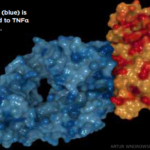- Do not start certolizumab during an active infection. If an infection develops, monitor carefully and stop certolizumab if the infection becomes serious.
- Invasive fungal infections—for patients who develop a systemic illness on certolizumab, consider empiric anti-fungal therapy for those at high risk who reside in or travel to regions where mycoses, such as histoplasmosis, coccidioidomycosis or blastomycosis, are endemic.
- Cases of lymphoma and other malignancies have been observed in patients receiving TNFi’s.
- Heart failure, worsening or new onset, may occur.
- Anaphylaxis or serious allergic reactions may occur.
- HBV reactivation can occur; test for HBV infection before starting certolizumab. Monitor HBV carriers during and several months after therapy. If reactivation occurs, stop certolizumab and begin anti-viral therapy.
- Demyelinating disease, exacerbation or new onset, may occur.
- Cytopenias, pancytopenia—advise patients to seek immediate medical attention if symptoms develop, and consider stopping certolizumab.
- Lupus-like syndrome—stop certolizumab if the syndrome develops.
Strategies to achieve remission &/or low disease activity include initiating disease-modifying anti-rheumatic drug therapy early in the disease course to slow & prevent joint damage.
Dosage & Administration
Certolizumab is administered by SQ injection. The recommended initial dose is 400 mg (two SQ injections of 200 mg each) and 400 mg at Weeks 2 and 4, followed by 200 mg every other week. A maintenance dose of 400 mg every four weeks can be considered.
Commentary
The FDA approval was based on clinical trials that enrolled more than 2,300 patients. The results showed RA patients taking Cimzia with MTX had a greater reduction in signs and symptoms of RA after 24 weeks of treatment than patients taking only MTX. Some patients showed clinical responses to certolizumab plus MTX within one to two weeks. The most common adverse reactions (≥7%) were upper respiratory tract infection, rash and urinary tract infection.
Etanercept (Enbrel):14 injection
Biosimilars: etanercept-szzs (Erelzi),15 etanercept-ykro (Eticovo)16
Drug class: DMARD, TNFi
Boxed warning: Refer to *ISI (p. 14)
Warnings & Precautions
- Do not start etanercept during an active infection. If an infection develops, monitor carefully and stop etanercept if the infection becomes serious.
- Consider empiric anti-fungal therapy for patients at high risk (those who reside in or travel to regions where mycoses, such as histoplasmosis, coccidioidomycosis or blastomycosis, are endemic) of invasive fungal infections who develop a severe systemic illness on etanercept.
- Demyelinating disease, exacerbation or new onset, may occur.
- Cases of lymphoma have been observed in patients receiving TNFi’s.
- Congestive heart failure, worsening or new onset, may occur.
- Advise patients to seek immediate medical attention if symptoms of pancytopenia or aplastic anemia develop, and consider stopping etanercept.
- Monitor HBV carriers for reactivation during and following therapy. If reactivation occurs, consider stopping etanercept and beginning anti-viral therapy.
- Anaphylaxis or serious allergic reactions may occur.
- Stop etanercept if lupus-like syndrome or autoimmune hepatitis develops.
Dosage & Administration
Etanercept is administered by SQ injection. The recommended initial dose is 50 mg once weekly with or without MTX.
Commentary
Etanercept was the first TNFi approved for the treatment of RA. The results of the clinical trials have demonstrated its clinical safety and efficacy in early, as well as established, disease. Patients with RA on etanercept were found to not only have reduced disease activity, but also have limited progression of joint damage in early and late disease. Etanercept can be used as a monotherapy or in combination with MTX, although the combination therapy appears to be more effective in terms of reducing joint damage. The most common adverse reactions (≥5%) were infections and injection-site reactions.
Golimumab (Simponi):17 injection
Drug class: DMARD, TNFi
Boxed warning: Refer to *ISI (p. 14)
Warnings & Precautions



